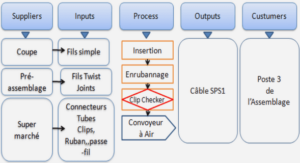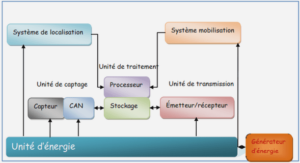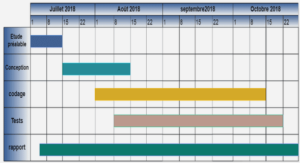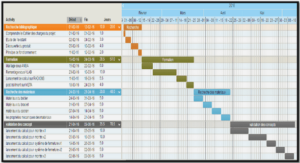Characteristics of seston and primary consumers
While the FA proxies between seston and Daphnia differed markedly, we observed less difference in the FA composition between thaw and non-thaw ponds (Table 2.2). Significant differences were observed only for the terrestrial and bacterial specific FA biomarkers in seston (P < 0.01, factorial two-way ANOVA) (Table 2.2). The amount of PUFA, omega-3, algal specific FA, and the PUFA:SAFA ratio were all highest in Daphnia. A similar ranking was also observed for the bacterial biomarker FA; however, their amount in seston was significantly lower in non-thaw ponds than thaw ponds (factorial two-way ANOVA, F1,77 = 8.236, P = 0.005). Specific terrestrial FA showed the opposite pattern; we recorded the lowest amounts of terrestrial FA in Daphnia and the highest amounts in seston. Non-thaw ponds recorded higher terrestrial FA values than thaw ponds. Moreover, the interaction effect between pond and material type was only significant for the PUFA (factorial two-way ANOVA, F1,77 = 4.543, P = 0.036).
Table 2.2 Mean values (± SD) of polyunsaturated (PUFA), omega-3, specific algal, terrestrial, bacterial, and polyunsaturated:saturated (PUFA:SAFA) fatty acids (FA) in seston and Daphnia pulex from non-thaw and thaw ponds. Units are expressed in μg mg-1 dry weight.
The isotopic signatures of Daphnia highlighted a strong difference (PERMANOVA, F1,10 = 9.476, P = 0.004) between the thermokarst and non-thaw ponds (Fig. 2.1a). The δ13C signature of Daphnia was more depleted in thaw ponds (-34.5 ± 1.1‰) than non-thaw ponds (-30.6 ± 1.1‰). SI signatures of Daphnia, however, had similar δ2H values for both pond types, ranging between -148.5‰ and -195.7‰. The NMDS ordination of Daphnia FA composition also separated the two pond types (PERMANOVA, F1,19 = 5.883, P = 0.001). NMDS associated the thaw-pond Daphnia with specific bacterial and algal FA, whereas Daphnia within the non-thaw ponds were associated with terrestrial biomarker FA (Fig. 2.1b).
As observed in Daphnia, phytoplankton δ13C was more depleted in thaw ponds than in non-thaw ponds (-35.7 ± 0.2‰ vs. -31.1 ± 0.1‰), whereas δ2H was similar for both pond types (-263.6 ± 3.4‰ vs. -259.0 ± 4.7‰) (Fig. 2.2). Terrestrial organic matter had similar δ13C and δ2H signatures for all ponds (-26.2 ± 0.8‰ vs. -24.9 ± 2.0‰, and -154.4 ± 4.0‰ vs. -160.8 ± 10.9‰, for thaw and non-thaw ponds, respectively).
Source contributions to primary consumers
Permafrost thaw affected Daphnia feeding as indicated by the SI composition of this zooplankton taxon (Fig. 2.2). Based on its location in the biplot (Fig. 2.2a), the Daphnia signature in the non-thaw ponds fitted well within the polygon of the source end-members and appeared to be composed mostly of benthic materials. In thaw ponds, however, Daphnia was positioned well outside the polygon with δ13C values closest to phytoplankton and δ2H closest to terrestrial sources (Fig. 2.2b). Accordingly, the SI mixing models showed a large contribution of benthic (median of 71%) and planktonic (median of 22%) algal material to Daphnia in non-thaw ponds, although the range of the 95% highest contribution probability was highly variable (2–99% and 0–89%, for benthic and planktonic material, respectively) (Fig. 2.3a). Terrestrial organic matter constituted a minor source in the non-thaw ponds (median of 3%). In the thaw ponds, phytoplankton was the major contributor to Daphnia (median of 57%), but we also observed a major shift to a higher proportion of carbon of terrestrial origin, making up 35% of the Daphnia biomass (median, Fig. 2.3b). The contribution from macrophytes was negligible (median of 5%).
Figure 2.2 Distribution of δ13C and δ2H Daphnia (Daph.) signatures in relation to the polygon of the potential sources (± SD) for (a) non-thaw ponds and (b) thaw ponds. The sources are phytoplankton (Phyt.), terrestrial organic matter (Terr.), benthic algae (Bent.), and macrophytes (Macr.).
The FA mixing models showed similar patterns for non-thaw and thaw ponds, the FA composition of Daphnia being mainly from phytoplankton (median of 78% and 67%, for non-thaw and thaw ponds, respectively), and more precisely from the algal planktonic group encompassing the Chlorophyceae and Cyanophyceae (Fig. 2.3c and 3d). In non-thaw ponds, the other sources had a significant but minor contribution (median less than 10%) (Fig. 2.3c). In the thaw ponds, however, a higher terrestrial contribution was observed (median of 18%), whereas macrophytes and Sphagnum were secondary contributors (median of 5% and 2%, respectively) (Fig. 2.3d).
Figure 2.3 Source contributions to Daphnia based on a dual isotope (δ13C and δ2H) Bayesian mixing model in ponds having (a) a tundra catchment unaffected by thermokarst processes and (b) a thawing permafrost catchment, and on Bayesian mixing models based on a 14 fatty acids in (c) non-thaw and (d) thermokarst ponds, respectively. The sources are phytoplankton (Phyt.), terrestrial organic matter (Terr.), benthic algae (Bent.), macrophytes (Macr.), Chlorophyceae and Cyanophyceae (Chloro. & Cyano.), Cryptophyceae (Crypto.), and Sphagnum (Sphag.). Box and whisker plots present the distribution of 50% and 95% highest densities of contribution probabilities, respectively, with the median value indicated by the line within each box.
Stimulating effect of permafrost thaw on algal biomass and zooplankton allochthony
Overall, permafrost thaw altered the chemical properties of the surface water and the different levels of the food chain from those measured in non-thaw ponds (Fig. 2.4). Excepting the amount of omega-3 in zooplankton, which was the same for both pond types (Table 2.2), all other variables were 76% to 1251% higher in the thaw ponds compared to the non-thaw ponds. While light absorption increased up to 247%, the availability of nutrients was also higher in thaw ponds (TP increased by 116%). This TP increase most likely more than compensated for the adverse effect of less light and explained the higher omega-3 content (177% increase) and Chla concentration (144% increase) in seston. When exposed to thawing permafrost and higher CDOM, the median allochthony of Daphnia increased by 1251% and 130% according to the SI and FA mixing models, respectively.
Figure 2.4 Effect of thawing permafrost (expressed in term of percentage of increase) on surface water chemical properties and different levels of the food chain, including the absorption coefficient of dissolved organic matter at 320 nm (a320) and 440 nm (a440), seston fatty acid omega-3 amounts (Seston omega-3), chlorophyll a (Chla), total phosphorus (TP) and dissolved organic carbon (DOC) concentrations, zooplankton fatty acid omega-3 amounts (Zoopl. omega-3), and zooplankton allochthony based on fatty acid (Allochth. FA) and stable isotope (Allochth. SI) mixing models.
Discussion
Our results show clearly that permafrost thaw alters both the physicochemical environment as well as the biomass composition of the planktonic food web in subarctic ponds; however, specific environmental variables and food web compartments were regulated very differently by the increased quantities of terrestrial carbon. In general, the non-living environment was more affected than the organisms. Within the food web, permafrost thaw had a greater effect on primary producers than primary consumers. While our results are in line with other studies indicating that browning influences biogeochemistry (Wauthy et al. 2018) and increases the allochthony of zooplankton (Wilkinson et al. 2013), we also showed that permafrost thaw stimulates rather than suppresses the production of high-quality omega-3 in the food web—within a mean DOC increase from 9 to 16 mg L-1—a pattern opposite to our hypothesis.
Permafrost thaw impact on light, nutrients, and algal biomass
Permafrost thaw induced important changes in the chemical properties of surface waters (Table 2.1, Fig. 2.4). The higher DOC and CDOM concentrations, supporting recent publications on DOM in the context of permafrost thaw (Vonk et al. 2015; Wauthy et al. 2018), strongly decreased light availability for primary producers. In the thaw ponds, only the uppermost meter remained sufficiently illuminated, and the majority of the water column received <1% of the incident PAR. Such high absorption is common in thaw ponds (Watanabe et al. 2011) and can shift primary production from benthic-dominated to pelagic-dominated production (Vadeboncoeur et al. 2008; Forsström et al. 2013). In oligotrophic arctic ponds surrounded by rocky catchments, this shift often leads to an overall decrease in total primary production—and hence lower algal biomass—because nutrient-limited phytoplankton cannot attain the high production levels of benthic algae (Rautio and Vincent 2006). In our study sites, the non-thaw ponds were oligotrophic and mesotrophic freshwaters and comparable to other clear-water arctic ponds (Rautio et al. 2011a). In our studied thaw ponds, the situation was different. Phosphorus concentrations were more typical of mesotrophic and eutrophic systems, with phosphorus likely originating from the degrading watershed, as observed in recent studies (Larsen et al. 2017). Consequently, the Chla concentrations were higher, suggesting a stimulated pelagic primary production from this greater nutrient influx (Vonk et al. 2015), whereas the relatively lower TP concentrations in the non-thaw systems produced Chla values similar to other circumpolar rock basins (Rautio et al. 2011a).
Increased supply of omega-3 fatty acids in thaw ponds
When terrestrial subsides of DOM increase, the food webs may shift from a reliance on autochthonous and autotrophic production to one based on heterotrophic production supported by terrestrial carbon (Rautio et al. 2011b; Mariash et al. 2018). In such conditions, a decline in the production and transfer of high-quality omega-3 is expected due to a reduction in phytoplankton biomass or dilution of the omega-3 by an increase in bacterial biomass (Creed et al. 2018). Whereas previous studies illustrated a high abundance of bacterial biomass in thaw ponds (Roiha et al. 2015), our results here show that the phytoplankton are able to concurrently sustain a high biomass. This may result from the dominance of flagellated (i.e., motile) and mixotrophic species that are known to dominate in thaw ponds (Forsström pers. comm., Roiha et al. 2015). Such organisms compensate for low light by phagotrophy on bacteria, and they can migrate daily to the deeper layers (Jones 1991) where higher nutrient concentrations occur below the thermocline (Roiha et al. 2015). In this environmental setting, Chla, PUFA, omega-3, and specific algal FA had higher concentrations in the seston of the thaw ponds (Table 2.2, Fig. 2.4).
The different phytoplankton SI values between both pond types reveal that the algal communities, or their metabolism, differed; this may also contribute to the differences in seston PUFA concentrations. The seston δ13C signatures were more depleted in ponds subjected to thawing permafrost (Fig. 2.2). This may result from the high concentration of methane in thaw ponds (Matveev et al. 2016) and its bioaccumulation in mixotrophic algae. Methane has a more negative δ13C value due to fractionation during methanogenesis; it can be metabolized by methanotrophic bacteria and then enter the food web (Bastviken et al. 2003). The phytoplankton community in the thaw ponds of the region is mainly mixotrophic (Bégin and Vincent 2017) and can rely on these methanotrophic bacteria as an energy source, explaining the more depleted δ13C signature of phytoplankton and hence Daphnia. Algal metabolism based on methanotrophic bacteria cannot, however, explain the higher PUFA, as bacteria lack these essential FA. We propose that the higher concentration of omega-3 in the thaw-pond seston is a combination of a high algal biomass, sustained by the high concentration of nutrients originating from the thawing permafrost, and a community composition dominated by motile mixotrophic algae that are able to access both nutrients and sufficient light.
Fatty acid composition of Daphnia
The FA composition of Daphnia in the thaw ponds associates zooplankton with specific bacterial FA (Fig. 2.1b). This matches the findings of previous studies that highlight the abundant bacterial communities and high bacterial growth in thaw ponds (e.g., Deshpande et al. 2016). The FA proxies confirmed this association, Daphnia being richer in FA biomarkers specific to bacteria in thermokarst freshwaters, although this is not significant (Table 2.2). However, the FA extraction method used in this study prevented us from separating and measuring the concentrations of FA specific to methanotrophic bacteria, such as C16:1n6c or C18:1n6c (Taipale et al. 2015). These specific FA are likely particularly important in thermokarst freshwaters, due to the high methane concentrations of these waterbodies (Matveev et al. 2016). Therefore, the amount of bacterial FA biomarkers may be underestimated in the thaw ponds relative to ponds not influenced by thawing permafrost.
Considering the strong terrestrial imprint on thermokarst systems (Wauthy et al. 2018), the higher amount of specific terrestrial FA in the non-thaw ponds for both Daphnia and seston was unexpected (Table 2.2). However, most limnological studies involving FA are carried out in boreal, temperate, or tropical regions having forested catchments. Consequently, FA considered as terrestrial, e.g., C20:0 or C22:0, are mostly FA specific to trees. Yet, the tundra landscape is very different, being deprived of most vascular plants and colonized mainly by small herbaceous plants and mosses. Therefore, using these FA as a proxy for terrestrial matter might not fit in the context of permafrost and arctic regions.
The amount of omega-3 in zooplankton was the same in the thaw and non-thaw ponds, despite the higher concentration of omega-3 in the seston of thaw ponds (Table 2.2, Fig. 2.4). This reduction in the transfer of omega-3 through the food chain could be explained by the dilution of these high-quality FA by the higher abundance of Daphnia in thaw vs. non-thaw ponds (4.1 vs. 0.4 individuals L-1, respectively), an increase in bacterial biomass, or a shift in algal community composition for the benefit of phytoplanktonic species of lower FA quality. While the latter has been suggested by Creed et al. (2018), the higher PUFA and omega-3 content of the seston in thaw ponds (Table 2.2) does not indicate a presence of a poorer quality algae. It may be that the phytoplankton production of PUFA in both pond types was sufficient to saturate the metabolic needs of Daphnia; therefore, the higher PUFA concentration in seston in thaw ponds was not displayed by Daphnia. This is supported by the higher content of PUFA, omega-3, algal FA biomarkers, and PUFA:SAFA ratio in Daphnia compared to seston (Table 2.2). This pattern emphasizes Daphnia’s ability to selectively accumulate and retain higher quality FA. The specific terrestrial FA also highlighted the selective assimilation, showing a reverse pattern with smaller amounts of these low-quality FA in Daphnia tissue as in seston.
Allocation of permafrost carbon to Daphnia biomass
Although the PUFA content of Daphnia was not significantly altered by exposure to permafrost carbon, the overall FA composition—along with the SI composition—showed that some organic material from the permafrost was assimilated by Daphnia, as was indicated by the zooplankton’s higher allochthony. We used SI- and FA-based mixing models to quantify the contribution of different organic material sources to Daphnia. The SI data and models emphasized a higher terrestrial imprint on Daphnia in ponds surrounded by degrading permafrost (Fig. 2.3a and 2.3b). In non-thaw ponds, Daphnia were supported mostly by autochthonous production, the model estimating a 94% contribution from benthic and pelagic algae (Fig. 2.3a). As expected, benthic algae contributed much more than phytoplankton in these ponds, given the low algal biomass and primary production in the water column compared to benthos (Rautio and Vincent 2006). Our findings support studies that have also highlighted the low contribution of phytoplankton to the food web of arctic ponds (Cazzanelli et al. 2012; Mariash et al. 2014). Indeed, given the absence of stratification in non-thaw ponds, benthic material can be resuspended (Evans 1994) and diffused (Rautio et al. 2011a; Rodríguez et al. 2013) throughout the entire water column, making it available for primary consumers. In thaw ponds, despite the higher imprint of phytoplankton, autochthonous algae contributed less to Daphnia, thereby emphasizing the influence of thawing permafrost on the food web (Fig. 2.3b). This is consistent with Wauthy et al. (2018) who highlighted the shift toward an increasing dominance of terrigenous organic carbon in freshwaters subjected to ongoing permafrost thaw. However, compared to the DOM allochthony in Wauthy et al. (2018), Daphnia in this study showed less terrestrial influence, again suggesting their ability to select higher quality food items in the water column.
It needs to be noted, however, that the Daphnia isotopic signature in the thaw ponds fell outside of the polygon defined by the 3 selected sources (Fig. 2.2b). Therefore, we must interpret the respective SI mixing models with some caution. One explanation could be that we missed an important food source of Daphnia in thaw ponds, although this seems unlikely. A more plausible explanation is that we estimated incorrectly the δ2H signature of phytoplankton in thaw ponds. The calculation developed by Wilkinson et al. (2013) is for phytoplankton growing in culture conditions that favor autotrophy. In thaw ponds, phytoplankton consist mostly of mixotrophic species (Bégin and Vincent 2017) and thus could be predominantly heterotrophic, feeding on bacteria and DOM. Therefore, in ponds strongly affected by terrestrial inputs, the δ2H of phytoplankton would be less depleted and closer to the deuterium of DOM (-153.9 ± 11.1‰), which is approximately in the same range as the Daphnia δ2H signature (169.6 ± 12.0‰). Thus, the isotopic signature of Daphnia would be much closer to the phytoplankton in thaw ponds, highlighting even more their ability to select higher quality food of autochthonous origin despite the overwhelming abundance of terrestrial organic matter in the water column.
The FA mixing models are consistent with previous studies (e.g., Galloway et al. 2014) and support the SI results, testifying to the importance of algae in the diet of Daphnia in both thaw and non-thaw ponds (Fig. 2.3c and 2.3d). Moreover, the significant contribution of phytoplankton of high biochemical quality (Cryptophyceae), despite their relatively low abundance in these freshwaters (L. Forsström pers. comm.), highlighted the ability of filter-feeding zooplankton to select higher quality food present in the water column. The FA-based models displayed similar patterns between non-thaw and thaw ponds; however as for the SI-based models, the FA emphasized the higher terrestrial imprint in those ponds surrounded by degrading permafrost. Nonetheless, this terrestrial contribution remained minor, suggesting no influence of degrading permafrost on the health of filter-feeding Cladocera, Daphnia being able to grow and reproduce while relying on poor-quality diets as long as high-quality food was available, even if only available in small quantities (Taipale et al. 2012).
An important assumption of these FA mixing models is that the differences in the FA content of Daphnia are driven by diet and the retention of lipids from this diet inside their tissues (Galloway et al. 2014). Other factors, such as temperature (Masclaux et al. 2009), zooplankton growth, and egg production (Vargas et al. 2006; Schneider et al. 2017) can directly influence lipids. Our sampling, however, was carried out over 2 short time windows, and consequently, the effects of different life-history stages on Daphnia FA content are assumed to be negligible.
Conclusion
Thawing permafrost induces rapid changes in northern freshwaters, releasing stocks of organic carbon that end up in aquatic systems and lead to a decrease of water column transparency. This in turn affects biogeochemical processes and the balance of autotrophic and heterotrophic production (Wauthy et al. 2018) and will favor algal species in the plankton at the expense of benthic algae (Karlsson et al. 2009; Forsström et al. 2013). Despite the significant influence of eroding and degrading permafrost on water chemistry, optical properties, and algae at the base of the trophic chain (Fig. 2.4), our results highlight the small impact of this extreme version of browning on higher levels of the food web, as terrestrial organic matter contributes little to the biomass of the filter-feeding Daphnia in arctic lakes. Our results show that phytoplankton remain the key resource that fuels the food web in arctic ponds and emphasize the ability of zooplankton to select a higher quality diet. Future work is needed to determine if Daphnia selectively forage on phytoplankton, or whether the high-quality FA are retained preferentially in zooplankton tissue.
Acknowledgments
We are grateful to the Centre for northern studies (CEN) Whapmagoostui-Kuujjuarapik Station and Claude Tremblay for providing us access to transportation and lab facilities. We also thank Alexandre Dubé, Félix Faucher, David-Alexandre Gauthier, Zoe Kroonenburg, Julien Lebrun, Flora Mazoyer, Sophie Robitaille, and Maxime Saunier for their help and cheerfulness in the field, Pierre Carrier-Corbeil for fatty acid analyses, Guillaume Grosbois for his advice regarding stable isotope data analyses, and Murray Hay for his editorial assistance. The funding was provided by the Canada Research Chairs Program, the Canada Foundation for Innovation, and the CEN. The PhD grant of Maxime Wauthy was partly supported by the Merit Scholarship Program for Foreign Students from the Ministère de l’Éducation et de l’Enseignement Supérieur du Québec.
References
The reference list of each individual chapter has been included in the final reference section at the end of the thesis.
Abstract
Climate change and associated permafrost thaw are creating new shallow waterbodies in vast regions of the circumpolar Arctic and provoking a shift from the dominance of oligotrophic clear-water ponds to a dominance of mesotrophic dark-water ponds. These thaw ponds are characterized by high concentrations of colored dissolved organic matter originating from the degrading watershed, inducing a strong vertical thermal stratification. We investigated the zooplankton community and biomass in 8 subarctic thaw ponds and evaluated the extent to which thermal stratification and associated environmental variables, including oxygen (O2), phytoplankton biomass, essential fatty acids (EFA), and bacteria and larval phantom midge Chaoborus biomass contribute to the vertical distribution of zooplankton in this increasingly common type of arctic freshwater system. The zooplankton community was extremely abundant in all ponds (up to 3548 ind L-1) and dominated mainly by rotifers (35%–93% of the biomass). The shallow epilimnion (0.2 to 1.5 m) was characterized by higher concentrations of dissolved O2 but low concentrations of seston EFA. Contrariwise, the water column beneath the thermocline was anoxic but rich in algae. According to weighted mean depth, most zooplankton aggregated from 0 to 1 m below the thermocline and their distribution was affected by a combination of O2, Chaoborus, phytoplankton, and EFA that were supplied from opposite directions. Our findings improve our understanding of arctic freshwaters in the context of thawing permafrost and the associated effects on the ecology of planktonic organisms.
Introduction
Frozen tundra soils represent a major component of circumpolar landscapes. They cover a considerable area of the Arctic (Zhang et al. 1999) and are one of the Earth’s largest pools of organic carbon (Schuur et al. 2015). Ongoing climate warming in subarctic regions is causing this ice-rich permafrost to thaw rapidly and favor thermokarst processes that create shallow waterbodies, hereafter referred to as thaw ponds (Vonk et al. 2015). These freshwater systems have increased rapidly in number at high latitudes over the last decades, and these ponds now represent one of the most abundant types of aquatic systems in the North (Grosse et al. 2013). They are strongly influenced by terrestrial inputs and act as recipients for large amounts of carbon and nutrients released from the degrading permafrost. As a result, water transparency and biogeochemical processes become highly altered (Wauthy et al. 2018). The growing influence of incoming terrigenous matter stimulates bacterial production (Deshpande et al. 2016) and respiration (Roehm et al. 2009) in these thaw ponds, making them highly net heterotrophic systems (Deshpande et al. 2015) and major greenhouse gases emitters to the atmosphere (Matveev et al. 2016). While the increasing amount of terrigenous nutrients also promotes pelagic primary producers (Przytulska et al. 2016), the high turbidity from these terrestrial inputs decreases light availability and induces a switch from benthic to pelagic primary production (Forsström et al. 2013). Furthermore, terrestrial inputs potentially reduce the nutritional quality of algae (Creed et al. 2018) and modify the species composition of primary consumers.
Although several studies have highlighted a stimulating influence of permafrost thaw on bacterial communities (e.g., Crevecoeur et al. 2015; Deshpande et al. 2016) and primary producers (e.g., Przytulska et al. 2016), few studies have investigated the higher trophic levels in thaw ponds. Nigamatzyanova and Frolova (2016) described the community structure of zooplankton in the thermokarst lakes of the Lena River delta in eastern Siberia, and they observed a higher diversity and abundance of rotifers compared to copepods or cladocerans. Bégin and Vincent (2017) had similar observations for thaw ponds in subarctic Quebec. They also highlighted that zooplankton abundance and biomass were higher in thaw ponds relative to ponds not affected by degrading permafrost. The dominance of rotifers can be explained by their pelagic feeding mode and their ability to graze very efficaciously on diverse sources of diet such as algae, bacteria, and even particulate organic matter (Arndt 1993). In addition, their particularly short lifespans and high reproductive rates make these r-strategy zooplankton particularly well adapted to perturbed environments (Jalal et al. 2005). Previous studies have also highlighted the ability of rotifers to gain an initial advantage when nutrients and phytoplankton biomass increase (Marty et al. 2002; Jalal et al. 2005) and have illustrated the importance of bottom-up controls on these microzooplankton (Yoshida et al. 2003). However, Bégin and Vincent (2017) found no such controls in thaw ponds, but rather they identified the importance of a top-down pressure on rotifers by Chaoborus larvae.
In addition to the stimulation of microzooplankton, permafrost thaw and the resulting terrestrial inputs from the degrading watershed induce a strong thermal stratification in thermokarst freshwaters (Breton et al. 2009). Consequently, deeper thaw ponds transform into a new environmental setting for arctic freshwaters. This steep thermal stratification has important implications for both the physicochemical environment and the organisms living in these systems. Thus, the distribution of nutrients through the water column of these thaw ponds is uneven; for example, Roiha et al. (2015) showed that total phosphorus levels were 6.5× higher in bottom waters than at the surface. Chlorophyll a (Chla) displayed the same pattern, ranging from 9.5 μg L-1 at the surface to 133.4 μg L-1 in the bottom waters. This suggests the presence of an abundant algal community in the deep hypolimnion of these deeper thermokarst freshwaters (Roiha et al. 2015). Prokaryotes and heterotrophic nanoflagellates may also have a strong vertical gradient (Roiha et al. 2015; Deshpande et al. 2016), and the substantial bacterial production coupled to the steep thermal stratification can induce severe hypoxia in the bottom waters of thaw ponds (Deshpande et al. 2015). The result is a marked impact on the organisms living in thermokarst systems.
Despite these major changes in circumpolar freshwaters due to permafrost thaw, the repercussions on the higher trophic levels have only been addressed superficially. The main objective of this study was to investigate the zooplankton community and biomass in subarctic thaw ponds and determine the main variables controlling their vertical distribution in the water column. Given the anticipated strong thermal structure and hypoxia observed in the hypolimnion of most sampled thaw ponds (Deshpande et al. 2015), we hypothesized a pronounced stratification of zooplankton. This stratification was expected to be the result of a compromise between a good-quality algal diet, oxygen (O2) accessibility, and top-down predation. To our knowledge, this study is the first to investigate in detail the vertical distribution of zooplankton and the main drivers of this distribution in thaw ponds.
Methods
Study sites
Field work was conducted in early August 2013 in a pair of thawing permafrost–affected valleys located in an area of sporadic permafrost near the village of Kuujjuarapik-Whapmagoostui, northern Quebec, Canada (55°17′N, 77°47′W). The Kwakwatanikapistikw River valley (KWK) is filled with numerous thaw ponds formed in clay-silt bed depressions created by the thawing of mineral palsas (Bouchard et al. 2011). Their watershed is mainly colonized by dense shrubs (Salix spp., Alnus crispa, Myrica gale) and sparse trees (e.g., Picea mariana, P. glauca, Betula glandulosa), with some patches of mosses (Sphagnum spp.) and macrophytes (Carex spp.) (Bouchard et al. 2011). The Sasapimakwananisikw River valley (SAS) is a peatland that is covered predominantly by mosses (Sphagnum spp.) and macrophytes (Carex spp.) and surrounded by thermokarst waterbodies and collapsing organic palsas (Arlen-Pouliot and Bhiry 2005). Most of the thaw ponds in KWK and SAS are small (mean surface area 157 m2) and shallow (depth 0.6–3.5 m) freshwaters Nhaving high nutrient (TP about 55 μg L-1) and dissolved organic matter concentrations (about 13 mg L-1), and a high turbidity (Breton et al. 2009) that severely limits the penetration of light through the water column. All sampled ponds are fishless. We sampled 4 ponds in the KWK (KWK1, KWK2, KWK6, and KWK12) and 4 others in the SAS (SAS2A, SAS2B, SAS2C, and SAS2D). Pictures of the study sites are available in the Supporting Information Fig. 3.S1. Further details about KWK and SAS are provided in Bouchard et al. (2014) and Arlen-Pouliot and Bhiry (2005).
Sample collection
We collected profiles of temperature, dissolved O2 concentrations, and photosynthetically active radiation through the water column of each sampled pond using a YSI 550A probe (YSI Inc., Yellow Springs, Ohio) and a PUV-2500 profiler radiometer (Biospherical Instruments, San Diego, California). In addition, we collected water for Chla, fatty acids, phytoplankton, and bacteria from 4–5 depths—that included the epi-, meta-, and hypolimnion—using a water sampler (Limnos Ldt., Turku, Finland). Zooplankton and Chaoborus phantom midge larvae were sampled from a 6-L water sample (3 replicates per depth) that was concentrated using a water sampler (Limnos Ldt., Turku, Finland) coupled to a 50-μm plankton net. The organisms were preserved in 4% formaldehyde until counting. The sampling took place between 12:00 and 16:00 to standardize the effect of potential diel vertical migration on plankton depth distribution.
In the lab, a 200-mL subsample of water (2 replicates) from each pond was filtered through a GF/F glass-fiber filter (0.7 μm, 47 mm, Whatman plc, Maidstone, United Kingdom) and stored at -80 °C until extraction in 95% ethanol to determine Chla concentration following the protocol of Nusch (1980). For 3 ponds (KWK6, KWK12, and SAS2A), water was also filtered for investigating bacterial and phytoplankton biomass and fatty acid concentrations. Prior to filtration, bacterioplankton were preserved by adding pre-filtered (0.2 μm) glutaraldehyde (2% final concentration) to a 10-mL sample and stored at 4 °C for 12 h. Each sample was then stained with 4′,6-diamidino-2-phenylindole (DAPI) (5 μg mL-1 final concentration) for 5 min and filtered through a nucleopore black polycarbonate membrane (0.22 μm, 25 mm, Whatman plc, Maidstone, United Kingdom) placed on the top of a GF/F glass-fiber filter (0.7 μm, 25 mm, Whatman plc, Maidstone, United Kingdom). The nucleopore membrane was then mounted on a microscope slide covered with non-fluorescent immersion oil and a cover slip and kept at -20 °C until counting. Phytoplankton were preserved with acid Lugol’s solution and stored at 4 °C until counting. Water samples for fatty acids were filtered onto pre-combusted and pre-weighted GF/F glass-fiber filters (0.7 μm, 47 mm, Whatman plc, Maidstone, United Kingdom). We visually inspected the filters and removed zooplankton and larger detritus before storing the filters at -80 °C.
Zooplankton community and biomass
The zooplankton community was identified and enumerated using the Utermöhl sedimentation method (Utermöhl 1958). Counts were made under an Axio Observer.A1 inverted microscope (Carl Zeiss, Oberkochen, Germany) at 100× to 400× magnification. At least 400 specimens were counted for each sample. To estimate the mean zooplankton biomass, we measured the body width and length of 10 individuals per species using microphotographs captured by an Axiocam ERc 5S coupled to the AxioVision Rel. 4.8.2. software (Carl Zeiss, Oberkochen, Germany). Rotifer biovolumes were estimated as per McCauley (1984). A 1:1 ratio was considered between the biovolume (in mm3) and the wet weight (in mg). This was converted to dry weight using a ratio of 0.1 as in Pace and Orcutt (1981). We calculated the biomass of the cladoceran Bosmina spp. and cyclopoid copepod nauplii as according to Rosen (1981), and we used the regression equations of Malley et al. (1989) to estimate the biomass of Holopedium gibberum and cyclopoid copepodites CI–CV. The biomass of the cladoceran Daphnia pulex was estimated as in Dumont et al. (1975). In addition to zooplankton, we counted the dipteran larvae Chaoborus sp. and measured their body length under a SteREO Discovery.V12 microscope (Carl Zeiss, Oberkochen, Germany). We then calculated their biomass following the regression equation of Mason (1977).
|
Table des matières
INTRODUCTION
0.1 Statement of the problem
0.2 State of the science
0.2.1 Permafrost in the Arctic
0.2.2 Permafrost thaw and thermokarst freshwaters
0.2.3 Dissolved organic matter
0.2.4 Allochthony in food webs
0.2.5 Zooplankton in arctic and subarctic thaw ponds
0.3 Thesis objectives, hypotheses, and structure
0.4 Methodological approach and study sites
CHAPTER I IMPORTANCE OF TERRESTRIAL ORGANIC MATTER IN NORTHERN FRESHWATER SYSTEMS LINKED TO THE PERMAFROST THAW
1.1 Scientific significance statement
1.2 Abstract
1.3 Introduction
1.4 Methods
1.4.1 Study regions
1.4.2 Chemical and biological analyses
1.4.3 Optical analyses
1.4.4 Stable isotope analyses
1.4.5 Mixing model
1.4.6 Statistical analyses
1.5 Results
1.5.1 Chemical, biological and optical properties
1.5.2 Source contributions to DOM
1.6 Discussion
1.6.1 Nutrients and primary producers
1.6.2 DOC and CDOM properties
1.6.3 DOM contribution quantification
1.7 Conclusions
1.8 Acknowledgments
1.9 References
1.10 Supporting information
CHAPTER II ZOOPLANKTON CARBON AND FATTY ACID COMPOSITION IN THE CONTEXT OF INCREASING DOMINANCE OF TERRESTRIAL ORGANIC MATTER DUE TO PERMAFROST THAW
2.1 Abstract
2.2 Introduction
2.3 Methods
2.3.1 Study sites
2.3.2 Sample collection
2.3.3 Limnological and optical analyses
2.3.4 Fatty acid analyses
2.3.5 Stable isotope analyses
2.3.6 Stable isotope and fatty acid mixing models
2.3.7 Statistical analyses
2.4 Results
2.4.1 Limnological and optical properties
2.4.2 Characteristics of seston and primary consumers
2.4.3 Source contributions to primary consumers
2.4.4 Stimulating effect of permafrost thaw on algal biomass and zooplankton allochthony
2.5 Discussion
2.5.1 Permafrost thaw impact on light, nutrients, and algal biomass
2.5.2 Increased supply of omega-3 fatty acids in thaw ponds
2.5.3 Fatty acid composition of Daphnia
2.5.4 Allocation of permafrost carbon to Daphnia biomass
2.6 Conclusion
2.7 Acknowledgments
2.8 References
2.9 Supporting information
CHAPTER III ZOOPLANKTON VERTICAL DISTRIBUTION IN SUBARCTIC FRESHWATERS IN THE CONTEXT OF PERMAFROST THAW
3.1 Abstract
3.2 Introduction
3.3 Methods
3.3.1 Study sites
3.3.2 Sample collection
3.3.3 Zooplankton community and biomass
3.3.4 Bacteria and phytoplankton biomass
3.3.5 Fatty acid analyses
3.3.6 Data analyses
3.4 Results
3.4.1 Limnological properties
3.4.2 Zooplankton community and biomass
3.4.3 Vertical distribution of zooplankton and the associated variables
3.5 Discussion
3.5.1 Limnological properties
3.5.2 Zooplankton community and biomass
3.5.3 Vertical distribution of zooplankton
3.6 Conclusion
3.7 Acknowledgments
3.8 References
3.9 Supporting information
GENERAL CONCLUSIONS
4.1 Main contributions
4.2 Implications of the results and potential avenues for future research
REFERENCES






